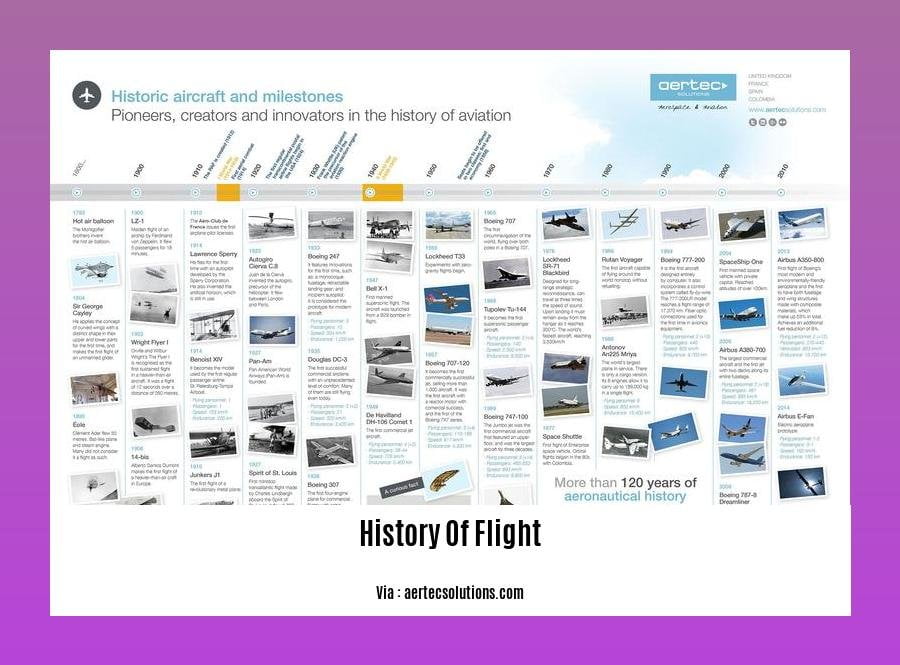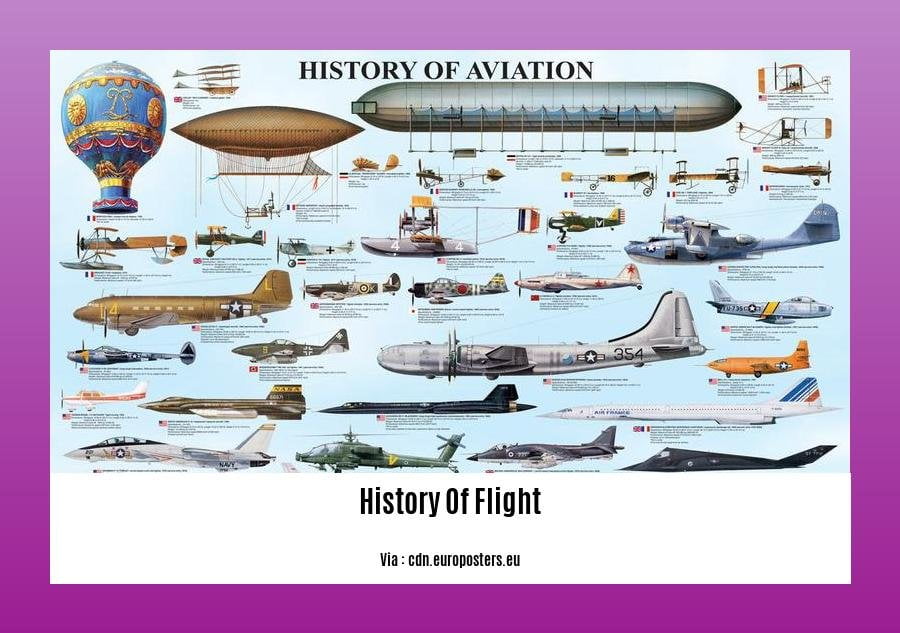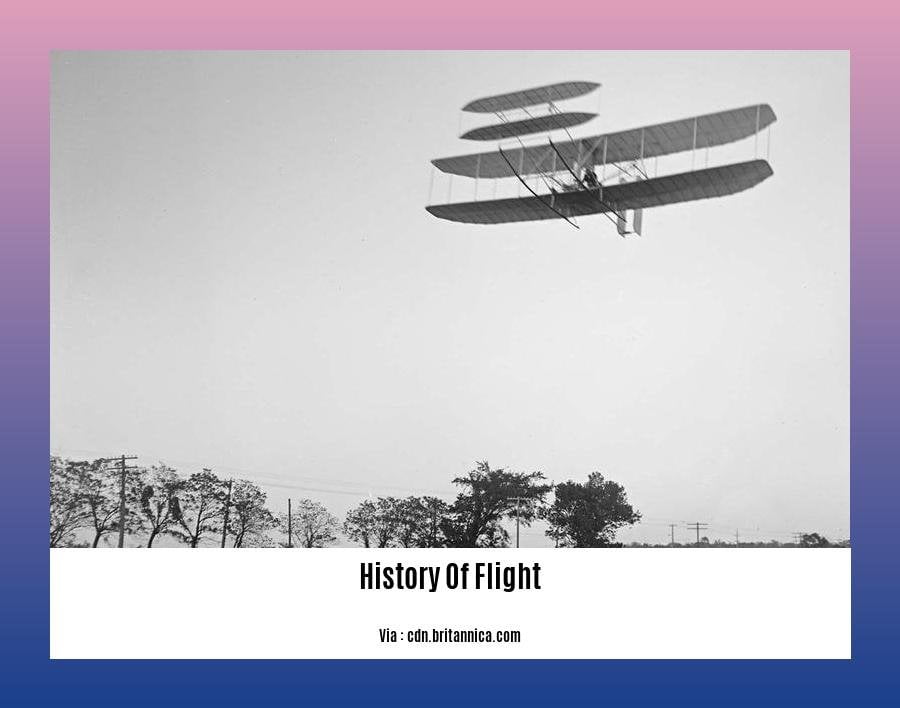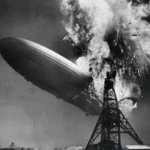Embark on an enthralling journey through “A History of Flight: From the Wright Brothers to the Jet Age.” This comprehensive account unveils the captivating evolution of flight, exploring the pivotal moments, influential figures, and revolutionary aircraft that have transformed our relationship with the skies.
Key Takeaways:
- Humans have been flying since the 18th century using balloons.
- The Wright brothers achieved powered, controlled airplane flight in 1903.
- Air travel became popular and accessible in the 20th century.
- Aviation advancements included military jets and space technology.
- Today, airplanes transport millions and space exploration continues.
- The future of flight involves electric, autonomous, and hypersonic vehicles, as well as space missions.
History of Flight

Early Pioneers:
The history of flight began with dreams of soaring like birds. Leonardo da Vinci sketched flying machines centuries ago, but it wasn’t until 1903 that the Wright brothers, Orville and Wilbur, achieved the first successful powered, controlled airplane flight. Their invention revolutionized transportation and warfare forever.
Golden Age of Aviation:
The early 20th century saw rapid advancements in aviation technology. Airplanes became faster, more efficient, and capable of carrying more passengers and cargo. Iconic aviators like Amelia Earhart and Charles Lindbergh captured the world’s imagination with their daring flights.
World War and Aviation:
Aviation played a pivotal role in World War I and II, from reconnaissance missions to aerial combat. The war accelerated technological progress, leading to the development of fighter jets, bombers, and radar systems.
Commercial Aviation Takes Off:
After the war, commercial aviation flourished. Airlines expanded their routes, and aircraft manufacturers produced larger, more comfortable planes. Air travel became accessible to the masses, connecting cities and countries worldwide.
Space Flight:
In the mid-20th century, humans took their first steps into space. Rockets launched satellites into orbit, and astronauts embarked on historic missions to the Moon. Space exploration expanded our understanding of the cosmos and pushed the boundaries of human ingenuity.
Modern Aviation:
Today, aviation continues to evolve rapidly. Composite materials, fly-by-wire systems, and unmanned aerial vehicles (UAVs) are transforming the way we fly. Electric and autonomous aircraft promise to revolutionize the industry once again.
The Future of Flight:
The future of flight holds endless possibilities. Electric, autonomous, and hypersonic vehicles are on the horizon, along with missions to Mars and beyond. As we push the boundaries of the skies, the legacy of flight will continue to inspire generations to come.
Did you know the Wright Brothers weren’t the first to fly? Delve into the history of aviation to discover how much there is to learn about the fascinating world of aviation. In the aviation timeline you’ll find significant events that shaped the industry as we know it today. The aircraft development history is a comprehensive look at how aircraft have evolved over time.
Golden Age of Aviation

The Golden Age of Aviation marked a pivotal period between 1919 and 1939, characterized by rapid advancements and widespread adoption of aviation technology. During this era, aviation evolved from its nascent beginnings into a game-changing industry.
Key Innovations
Monoplanes emerged as the preferred aircraft configuration, with advances in aerodynamics and structural design.
Enclosed cabins enhanced comfort and safety for passengers.
Improved engines increased power and efficiency, allowing aircraft to fly longer distances and reach higher altitudes.
Notable Aviators
Amelia Earhart captivated the world with her solo transatlantic flights, becoming an aviation icon.
Charles Lindbergh’s famous solo flight across the Atlantic cemented the United States’ role in aviation history.
Impact on Society
Aviation played a key role in commerce and trade, facilitating the transport of goods and people.
It introduced a new era of exploration and adventure, as pilots pushed the boundaries of what was possible.
Aviation also revolutionized warfare, with aircraft playing a critical role in reconnaissance and combat.
Legacy
The Golden Age of Aviation laid the foundation for modern air travel. Its innovations and accomplishments continue to inspire future generations. It sparked an insatiable thirst for exploration and solidified aviation’s place as a transformative technology.
Key Takeaways:
– The Golden Age of Aviation was a time of transformative advancements in aviation technology.
– Notable aviators like Amelia Earhart and Charles Lindbergh captivated the public’s imagination.
– Aviation’s impact revolutionized commerce, exploration, and warfare.
– The legacy of this era continues to shape modern air travel and inspire future aviation endeavors.
Relevant URL Source:
What Was The Golden Age of Aviation?
World War I and Beyond
Post-War Utility Aviation
After World War I, airplanes soared into new frontiers for “utility aviation” (Britannica). Pilots took to the skies for varied tasks, transforming aircraft into practical tools for transportation and business.
Advancements in Aircraft and General Aviation
Despite the Great Depression, aviation technology surged ahead in the 1930s (Britannica). Igor Sikorsky’s contributions to piston-engine helicopter development were instrumental in this progress.
General Aviation’s Post-War Rise
Post-World War II, non-military and non-scheduled air transport took off, giving birth to “general aviation” (Britannica). Manufacturers like Piper, Cessna, and Beechcraft dominated this realm, producing a fleet of light aircraft that fueled the industry’s expansion.
Key Takeaways:
- World War I sparked the use of aircraft for diverse practical purposes.
- Advancements in aircraft technology continued unabated despite the Great Depression.
- Post-World War II, general aviation emerged as a significant industry, with manufacturers like Piper, Cessna, and Beechcraft leading the way.
Most Relevant URL Source:
- Britannica:
Commercial Aviation
Key Takeaways:
- Wilbur Wright’s first passenger flight in 1908 marked the beginning of commercial flight.
- DELAG, a German airship company, established the world’s first airline in 1909.
- The Douglas DC-3 (1935) revolutionized commercial flight with its larger capacity and propeller-driven design.
- Laker Airways (1966) introduced low-cost “no-frills” airlines, making air travel more accessible.
- The 1950s and 1960s witnessed a surge in jet engine aircraft, leading to an expansion of commercial air travel.
Origins and Pioneers:
Imagine soaring through the skies like a bird! That’s what the Wright brothers realized in 1903 with their first successful flight. It paved the way for commercial aviation as we know it today.
Dawn of Airlines:
Soon enough, companies like DELAG emerged, pioneering scheduled air services. And guess what? The first airline ticket cost a whopping $480!
The Golden Age:
The 1930s and 1940s saw a boom in commercial aviation. The Douglas DC-3, with its sleek design and spacious cabin, became a game-changer for passenger travel.
Revolutionizing Air Travel:
The jet engine, introduced in the 1950s, transformed commercial aviation. Jets flew faster, farther, and higher, making air travel more convenient and accessible.
The Modern Era:
Today, commercial aviation is a global industry. From low-cost carriers to luxurious private jets, there’s an option for every traveler.
The Future of Flight:
As technology advances, so will commercial aviation. Electric aircraft, autonomous flight, and supersonic travel are just a glimpse of what’s to come. Who knows, someday we might even be flying to the stars!
Most Relevant URL Source:
A Very Brief History of Commercial Aviation | First Flight Foundation
FAQ
Q1: What is the significance of the 18th century in the history of flight?
A1: The 18th century marked a pivotal advance in aviation with the invention of balloons, allowing humans to achieve flight for the first time.
Q2: How did the Wright brothers make their mark on the history of flight?
A2: In 1903, the Wright brothers achieved the first powered, controlled airplane flight, revolutionizing the field of aviation and laying the foundation for modern air travel.
Q3: What factors contributed to the rapid growth of air travel in the 20th century?
A3: The 20th century witnessed advancements like transatlantic flights and jet airliners, making air travel more efficient, accessible, and popular around the globe.
Q4: How did aviation progress in the military and space realms?
A4: In the military, aviation saw the development of supersonic jets and stealth bombers, while in space, it led to advancements in rockets and satellites, expanding human exploration and understanding of the cosmos.
Q5: What is the future of flight, and what exciting developments can we expect?
A5: The future of flight holds promising developments such as electric, autonomous, and hypersonic vehicles, along with missions to the Moon and Mars, pushing the boundaries of aviation even further.
















